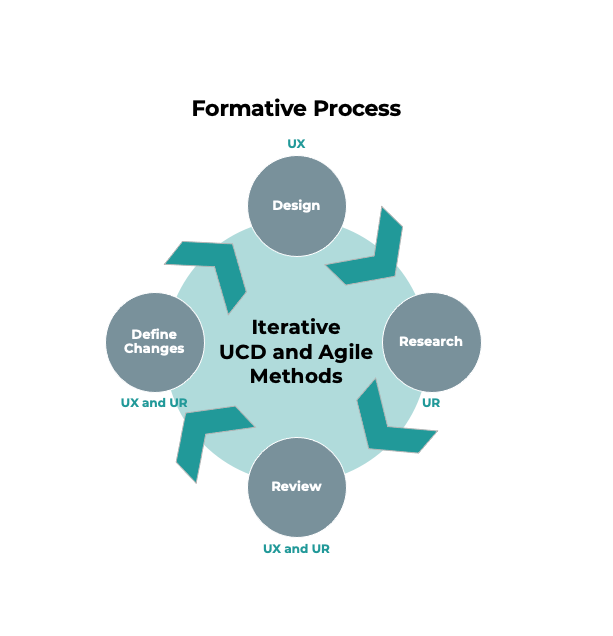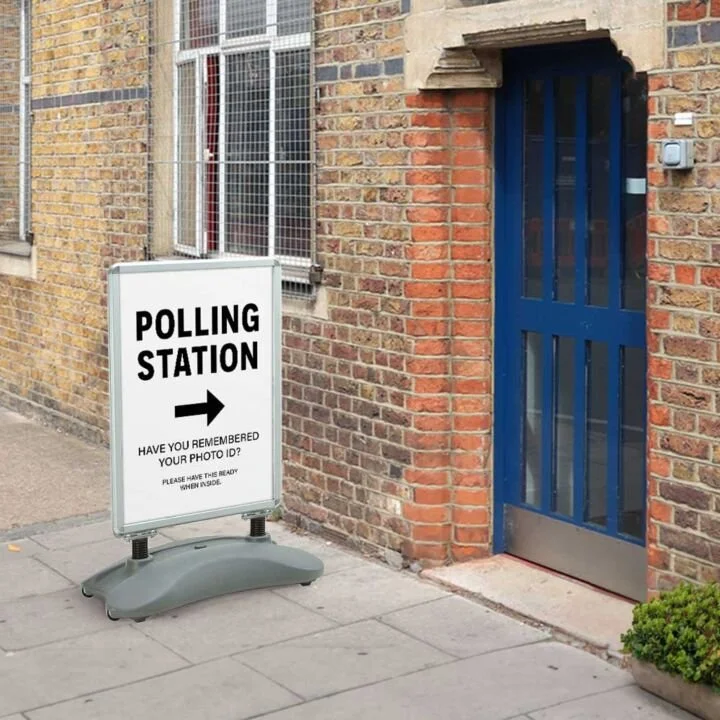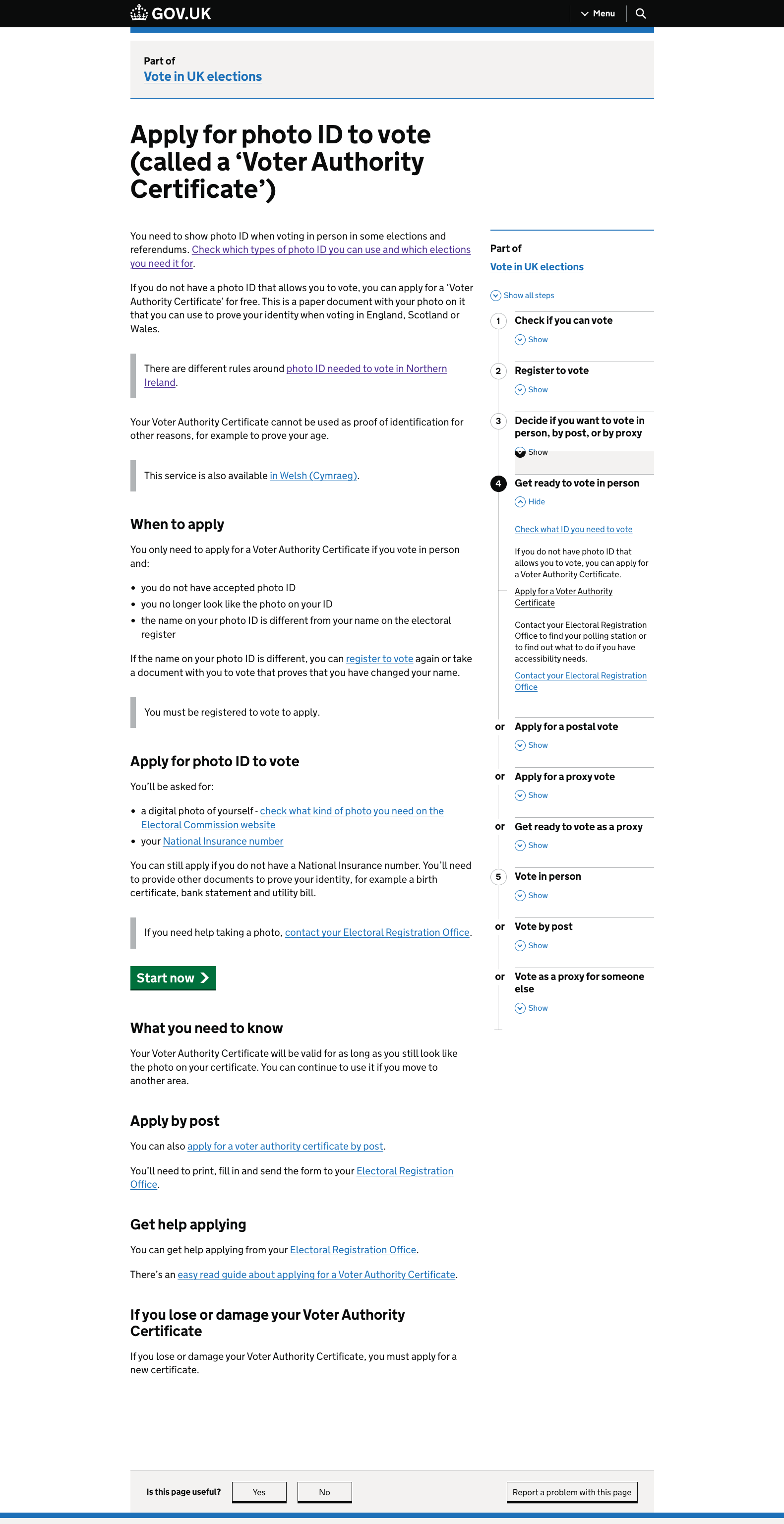
Cabinet Office
Made voter ID accessible by addressing the needs of voters without valid ID
Overview
Photographic ID is now mandatory for voting at polling stations. Data indicates that approximately 4% of the UK voting population does not possess an approved form of photo identification.
Valtech was appointed by the Cabinet Office to design and implement a service enabling voters without valid photo ID to obtain a free voter card in time for the election. This service comprised of two key stages:
Eligibility triaging:
Assessed voters’ need for a voter card through a structured triage process.
Application process:
Facilitated online applications, supported by a non-digital backup service to ensure accessibility for all users.
Additionally, we developed a dedicated portal for Electoral Role Officers to efficiently manage and process submitted applications, streamlining the printing and distribution of voter cards.
This initiative was critical in ensuring voter inclusion and upholding public trust in the electoral process, particularly for underserved populations without photo ID.
My role: Principal UX Designer / User Researcher
Agency: Valtech
Team: Valtech: Business Analyst, Technical Architect, Delivery Manager, UCD Lead, User Researchers.
Cabinet office: Service Owner, Content Designer, SMEs, Policy Team, Business Change Team, Head of Digital Elections Division
Project duration: 6 months, successfully completing the Alpha GDS & CDDO assessment to advance to the Beta phase.
Location: Remote
Deliverables: Workshop design and facilitation, user journeys, wireframes, prototypes, user research (planning, recruitment, facilitation & analysis)
The problem
The service needed to cater to diverse user groups, minimise administrative burdens on Electoral Registration Officers (EROs), and ensure secure, timely distribution of Voter Cards without overwhelming local authorities.
Project Goals:
Provide a seamless digital and non-digital application experience.
Enable local authorities to process applications efficiently using a digital portal.
Ensure timely production and delivery of Voter Cards for all eligible voters.
Importance:
The project was critical to ensuring voter inclusion while mitigating fraud risks. The balance between accessibility and security was essential for a credible election process.
Stakeholder Needs:
Voters: Accessible service to obtain free voter ID, even for those with limited digital access.
Local Authorities (EROs): Efficient tools to manage application workflows and issue cards.
Policy Makers: A solution meeting legislative requirements and delivering value for taxpayers.
Success Metrics:
GDS & CDDO Alpha assessment approval for progression to Beta.
High user satisfaction, task completion rates, and error-free applications during testing phases.
Initial planning and set up
My contribution
Co-facilitated inception workshops with the BA to define user needs, success metrics, assumptions, and potential risks, while establishing Agile ways of working. Workshops were conducted over Teams using Lucid Charts.
Reviewed all discovery materials, including the initial service blueprint, user research insights, and policy team requirements, to ensure alignment with legislative goals and user needs.
Collaborated with the BA to input on the initial stages of the target operating model and service blueprint, ensuring they were grounded in the findings from the discovery phase.
Engaged with stakeholders, including the policy team, to identify constraints, legislative priorities, and critical success factors that would shape the overall service vision and inform early design decisions.
Reviewed similar services (e.g., Blue Badge and Register to Vote) to identify best practices and ensure the service incorporated proven patterns where applicable.
Reviewed the GDS Design System to identify relevant patterns and components that could be applied to the Voter Card service.
Design
My contribution
Kicked off the design phase with a series of working sessions involving the service owner, content designer, and policy SME. These sessions focused on mapping out initial user flows, identifying potential challenges, and refining early ideas to align with policy requirements and user needs. They also established key areas of focus and uncovered unanswered questions requiring further input.
Designed the UI for the Voter Card application service on GOV.UK and the Local Authority (LA) portal for processing and distributing Voter Cards.
Developed user flows, wireframes, and prototypes for formative testing, ensuring design solutions improved through iterative feedback and aligned with sprint goals. Used Lucidchart and Axure to collaboratively design and refine concepts.
Worked with the Technical Architect to develop and refine a fully functioning prototype for summative testing using the GDS Nunjucks prototyping kit.
This video showcases an early Axure prototype of the triage flow for the Voter Card service. The interactive prototype includes built-in logic to guide users through the application process based on their responses, helping determine if they need a voter card.
Research & collaboration
My contribution
Conducted formative research for the Voter Card application service, using a user-centered design approach in collaboration with a user researcher. Insights from this research directly shaped design updates during Agile sprints.
Facilitated six co-design workshops, resulting in four iterations of the Local Authority portal. Participants included representatives from UX, service design, business analysis, business change, and policy teams, alongside a number of local authorities from across the UK. This diverse group ensured a wide range of perspectives, including different authority types, political leaderships, and roles within Electoral Registration Offices.
Onboarded additional researchers and UX designers to expand the formative research efforts and work on related voter service workstreams. Ensured alignment across teams and maintained collaboration as the project scaled.
Collaborated with the Technical Architect to address challenges identified during research, providing actionable recommendations to update the prototype in preparation for summative testing.
We engaged with diverse user groups—including retired individuals, transgender people, culturally homogeneous communities, white working-class and unemployed individuals, homeless people, women wearing head or face coverings, people with disabilities, and general voters. This work ensured the service was inclusive and addressed accessibility, trust, and usability challenges effectively.
Refined the target operating model and service blueprint with the BA, incorporating emerging user insights and research findings from design and testing sprints.
Ensured compliance and usability by guiding the team on GDS design patterns and best practices throughout the project.
Prepared for the GDS & CDDO assessment, supporting the team with documentation and evidence. Participated in both the mock and final assessments to ensure the service met the required accessibility, usability, and design standards.
Key challenges and solutions
The project faced a range of challenges, but two critical obstacles emerged as priorities: optimising the triage process to minimise unnecessary applications and ensuring the tight application deadlines were operationally feasible.
Obstacle: Triage Effectiveness
In early testing, many users who did not actually need a Voter Card (because they already had valid photo ID) said they would still apply, which would risk of overwhelming Electoral Registration Officers (EROs) with unnecessary applications.
Solution:
We implemented and tested persuasive content and design nudges to deter unnecessary applications. Strategies included:
Highlighting limitations of the Voter Card, such as its specific use for voting only.
Appealing to social responsibility, encouraging users not to apply if they already had valid ID.
Providing information on other forms of ID that might be easier to obtain, such as free travel passes for eligible individuals.
While user research showed these strategies would reduce the number of unnecessary applications, ongoing testing revealed that some users would still apply for convenience. This feedback was used to advocate for removing the application option for users who were explicitly informed they didn’t need the card, which was eventually implemented.
Key challenges and solutions
Obstacle: Tight deadlines
ERO teams faced significant operational challenges due to the expected timelines for processing and delivering Voter Cards, particularly during peak periods close to the election. These constraints risked overwhelming local authorities and jeopardising service efficiency.
Solution:
I facilitated workshops with EROs across multiple local authorities to stress-test workflows and assess the feasibility of proposed timelines. Insights from these sessions helped:
Highlight the risks associated with the original timeline, such as bottlenecks in printing and distribution, and logistical challenges in reaching remote areas.
Identify alternative workflows to manage and issue cards more efficiently within the required timeframes.
Advocate for more realistic policy deadlines to ensure operational feasibility and reduce the burden on local authorities.
This collaborative effort led to a reassessment of the initial timeline, resulting in adjusted deadlines that balanced operational efficiency with user needs.
Outcomes and impact
Results Achieved:
Passed the GDS & CDDO Alpha assessment, enabling progression to Beta.
Voter Card application service summative testing: 99% task completion rate, 0.3% error rate, and high user satisfaction.
Collaborated with EROs to co-design workflows for the Local Authority portal, resulting in streamlined processes and enhanced tools for workload management. The final design effectively met user needs and supported day-to-day operational efficiency.
Testimonials:
Feedback from users and EROs highlighted the practicality and usability of the designs.
EROs appreciated the collaborative approach and the focus on addressing their operational needs.
Business Impact:
Mitigated risks of ERO overload while meeting legislative requirements.The research and iterative design process identified and addressed key risks, including:
Potential operational challenges with tight application deadlines: By presenting evidence to the policy team, the project mitigated issues that could have impacted public trust.
Risk of unnecessary applications: Adjustments to the application process, significantly reduced unnecessary applications, easing the workload for Electoral Registration Officers (EROs) and ensuring the system remained efficient and focused on those who genuinely needed a Voter Card.
The service reached diverse, underserved user groups who may not traditionally engage with digital services. By offering multiple application channels (digital, paper, and assisted routes), the project ensured no voter was left behind.




